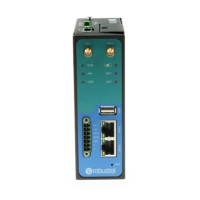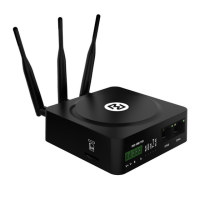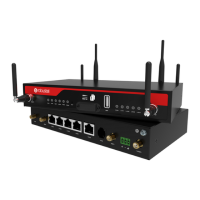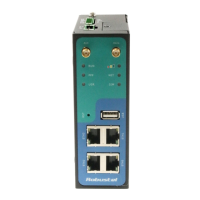Do you have a question about the Robustel GoRugged R3000-3P and is the answer not in the manual?
| Product Type | Industrial Cellular Router |
|---|---|
| Cellular Interface | Mini PCIe |
| Ethernet Ports | 3 |
| WAN Ports | 1 |
| LAN Ports | 2 |
| Power Supply | 9-36 VDC |
| Housing | Metal |
| Ingress Protection | IP30 |
| Cellular Connectivity | LTE, 3G, 2G |
| Ethernet Interface | 10/100 Mbps |
| Wi-Fi | 802.11 b/g/n |
| Serial Interface | RS232/RS485 |
| Operating Temperature | -40°C to +70°C |
| VPN Support | IPsec, OpenVPN |
Product description for the Robustel GoRugged R3000-3P.
Specifies the network type supported by the router.
Provides information about the document's content.
Provides contact details for technical assistance.
Covers general safety guidelines for using the router.
Information regarding radio frequency exposure limits and compliance.
Guidelines for vehicle operation and router care.
Lists relevant European Union directives for the product.
Lists Chinese standards for hazardous substances in electronic products.
Specifies limits for hazardous substances in product parts.
Provides a general overview of the Robustel GoRugged R3000-3P.
Lists the items included in the product package.
Details the technical specifications of the router.
Information for selecting and ordering the product.
Explains the function of each LED indicator on the router.
Provides instructions on how to mount the router physically.
Shows the pinout for router connections.
Explains the importance and method of grounding the router.
Describes the function and usage of the reset button.
Details the serial port specifications.
Describes the digital input and output specifications.
Lists system-level features like LEDs, RTC, and expansion.
Details software features, protocols, and management options.
Specifies power requirements and consumption.
Describes the physical dimensions, weight, and mounting options.
Specifies operating and storage temperature and humidity ranges.
Lists product certifications and compliance.
Details the procedure for inserting SIM and Micro SD cards.
Instructions for connecting an external antenna.
Shows the pinout for router connections.
Explains the importance and method of grounding the router.
Describes the function and usage of the reset button.
Steps to configure a Windows PC for router access.
Lists the default username, password, and IP addresses.
Saves configuration and reboots the router.
Provides interface navigation and assistance options.
Applies or cancels configuration changes.
Displays system status, router info, and WAN link status.
Shows details about the router's model, firmware, and uptime.
Details the current status of the WAN connection.
Provides status details for the cellular connection.
Manages SIM card PIN entry for authentication.
Sets connection mode, redial interval, and max retries.
Enables connections triggered by SMS, Tel, or Serial Data.
Defines conditions for switching between SIM cards.
Configures data limits and roaming behavior.
Selects the primary SIM card for network access.
Configures automatic switching to backup SIM.
Configures data limits and roaming behavior.
Configures LAN-specific settings like DHCP server.
Configures serial port for transparent data transmission.
Configures serial port for Modbus communication.
Settings for transparent protocol mode.
Settings for Modbus protocol mode.
Settings for AT Over COM protocol mode.
Sets up rules to forward incoming traffic to specific internal devices.
Configures the DMZ host for exposing services to the internet.
Basic firewall settings for remote access and DoS protection.
Detailed filtering rules for firewall policy.
Binds specific MAC addresses to IP addresses for security.
Manually defines static routes for network traffic.
Configures Routing Information Protocol (RIP) for dynamic routing.
Configures Open Shortest Path First (OSPF) for dynamic routing.
Basic settings for IPSec VPN.
Configuration for individual IPSec tunnels.
Key exchange parameters for IPSec.
Security Association parameters for IPSec.
Advanced settings for IPSec VPN.
Configuration for X.509 certificates in IPSec.
Manages authentication certificates for VPNs.
OpenVPN client configuration settings.
OpenVPN server configuration settings.
OpenVPN client configuration settings.
OpenVPN server configuration settings.
Manages OpenVPN client configurations.
L2TP client configuration settings.
L2TP server configuration settings.
Common settings for L2TP server.
Advanced settings for L2TP server.
PPTP client configuration settings.
PPTP server configuration settings.
Basic SNMP settings for the router.
Defines SNMP views and access control.
Tools for testing network connectivity via Ping.
Tools for sending and receiving AT commands to the cellular module.
Tools for tracing network paths.
Example configuration for cellular dial-up connection.
Example for configuring cellular connection in 'Always Online' mode.
Example for configuring cellular connection in 'Connect on Demand' mode.
Example of configuring port forwarding rules.
Example setup for L2TP server.
Example setup for L2TP client.
Example setup for PPTP server.
Example setup for PPTP client.
Example setup for IPSec VPN client.
Example setup for OpenVPN server.
Example setup for OpenVPN client.
Explains CLI modes and hierarchy.
Description of the user executive mode in CLI.
Description of the privileged executive mode in CLI.
Description of the global configuration mode in CLI.
Description of the interface mode in CLI.
Guidance on configuring the router using the CLI.
Tips and common commands for CLI usage.
Quick start examples for CLI configuration.
CLI example to display the router's current version.
CLI example for updating firmware using TFTP.
CLI example for setting link management parameters.
CLI example for configuring Eth0 IP, Gateway, and DNS.
CLI example for cellular dial-up configuration.











